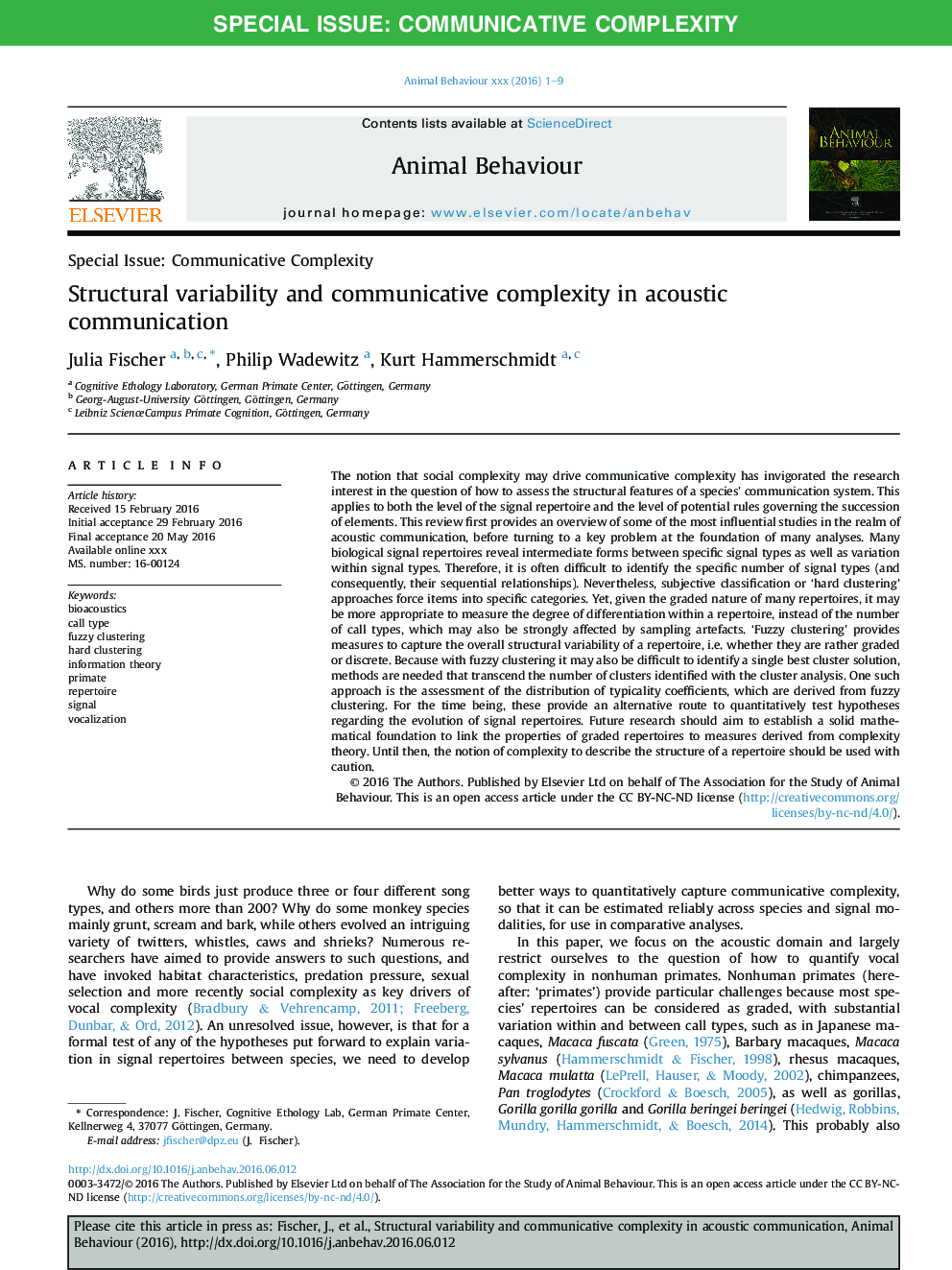| کد مقاله | کد نشریه | سال انتشار | مقاله انگلیسی | نسخه تمام متن |
|---|---|---|---|---|
| 8488810 | 1552194 | 2017 | 9 صفحه PDF | دانلود رایگان |
عنوان انگلیسی مقاله ISI
Structural variability and communicative complexity in acoustic communication
ترجمه فارسی عنوان
تنوع ساختاری و پیچیدگی ارتباطی در ارتباطات صوتی
دانلود مقاله + سفارش ترجمه
دانلود مقاله ISI انگلیسی
رایگان برای ایرانیان
کلمات کلیدی
ترجمه چکیده
مفهوم پیچیدگی اجتماعی ممکن است باعث پیچیدگی ارتباطی شود، علاقه تحقیق به سوال از نحوه ارزیابی ویژگی های ساختاری یک سیستم ارتباطی گونه را افزایش داده است. این امر به میزان سطح ریزپردازنده سیگنال و سطح قوانین بالقوه حاکم بر جانشینی عناصر مربوط می شود. این بررسی برای اولین بار یک مرور کلی از برخی از مطالعات تاثیر گذار در حوزه ارتباطات صوتی ارائه می دهد، قبل از تبدیل شدن به یک مشکل کلیدی در پایه ای از بسیاری از تجزیه و تحلیل. بسیاری از پرونده های سیگنال بیولوژیکی فرم های متوسط را بین انواع سیگنال های خاص و همچنین تغییرات در انواع سیگنال نشان می دهند. بنابراین، اغلب دشوار است تعداد مشخصی از انواع سیگنال ها (و در نتیجه، روابط متوالی آنها) را مشخص کند. با این وجود، طبقه بندی ذهنی یا خوشه بندی خوشه ای سخت، اقلام را به دسته های خاص تبدیل می کند. با این حال، با توجه به ماهیت درجه بندی بسیاری از رپرتوری ها، ممکن است بیشتر به اندازه تعداد تمایز در یک رپرتویور، به جای تعداد انواع تماس ها، اندازه گیری شود که ممکن است توسط آثار نمونه برداری نیز تحت تاثیر قرار گیرد. خوشه فازی "اقدامات لازم را برای تطبیق تغییرات ساختاری کلی یک رپرتیور فراهم می کند، یعنی اینکه آیا آنها به نسبت درجه بندی شده یا گسسته هستند. از آنجایی که با خوشه بندی فازی ممکن است دشوار باشد که یک راه حل خوشه ای را به صورت یکپارچه شناسایی کنیم، لازم است روش هایی که تعداد خوشه های شناسایی شده با تجزیه خوشه را فراتر می گذارند، باشد. یکی از این روش ها ارزیابی توزیع ضرایب تکراری است که از خوشه بندی فازی حاصل می شود. در حال حاضر این روش جایگزین برای سنجش کمی فرضیه ها در مورد تکامل مجدد سیگنال ها را فراهم می کند. تحقیقات آینده باید هدف ایجاد یک پایه ریاضی جامد برای پیوند دادن خواص مجتمع های درجه بندی شده به اقدامات حاصل از نظریه پیچیدگی. تا آن زمان، مفهوم پیچیدگی برای توصیف ساختار یک مجسمه باید با احتیاط مورد استفاده قرار گیرد.
موضوعات مرتبط
علوم زیستی و بیوفناوری
علوم کشاورزی و بیولوژیک
علوم دامی و جانورشناسی
چکیده انگلیسی
The notion that social complexity may drive communicative complexity has invigorated the research interest in the question of how to assess the structural features of a species' communication system. This applies to both the level of the signal repertoire and the level of potential rules governing the succession of elements. This review first provides an overview of some of the most influential studies in the realm of acoustic communication, before turning to a key problem at the foundation of many analyses. Many biological signal repertoires reveal intermediate forms between specific signal types as well as variation within signal types. Therefore, it is often difficult to identify the specific number of signal types (and consequently, their sequential relationships). Nevertheless, subjective classification or 'hard clustering' approaches force items into specific categories. Yet, given the graded nature of many repertoires, it may be more appropriate to measure the degree of differentiation within a repertoire, instead of the number of call types, which may also be strongly affected by sampling artefacts. 'Fuzzy clustering' provides measures to capture the overall structural variability of a repertoire, i.e. whether they are rather graded or discrete. Because with fuzzy clustering it may also be difficult to identify a single best cluster solution, methods are needed that transcend the number of clusters identified with the cluster analysis. One such approach is the assessment of the distribution of typicality coefficients, which are derived from fuzzy clustering. For the time being, these provide an alternative route to quantitatively test hypotheses regarding the evolution of signal repertoires. Future research should aim to establish a solid mathematical foundation to link the properties of graded repertoires to measures derived from complexity theory. Until then, the notion of complexity to describe the structure of a repertoire should be used with caution.
ناشر
Database: Elsevier - ScienceDirect (ساینس دایرکت)
Journal: Animal Behaviour - Volume 134, December 2017, Pages 229-237
Journal: Animal Behaviour - Volume 134, December 2017, Pages 229-237
نویسندگان
Julia Fischer, Philip Wadewitz, Kurt Hammerschmidt,
